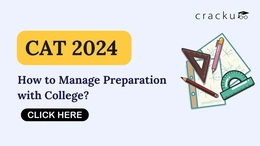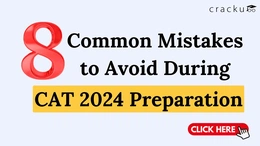From fundamental concepts to advanced problem-solving techniques, each question is meticulously crafted to evaluate your geometric prowess. Whether you're a novice seeking to build a solid foundation or a seasoned aspirant aiming for perfection, these questions will challenge your understanding and application of geometric principles. Fundamental for excelling in the Geometry section of the CAT Quant. Geometry plays a significant role in the CAT Quantitative section, and one of the fundamental concepts within geometry is understanding quadrilaterals. Quadrilaterals are polygonal shapes with four sides. Mastering the properties, formulas, and theorems related to quadrilaterals is crucial for excelling in CAT exams. You can check out these CAT Geometry questions from the CAT Previous year papers. Regular practice with free CAT mocks is highly recommended as it offers a comprehensive understanding of question patterns and refining strategies for tackling Geometry Misceallaneous questions efficiently. These mock tests are invaluable tools for familiarizing yourself with the questions commonly encountered in CAT exams.
Also Read, CAT Eligibility Criteria 2024
Question 1
The base of a regular pyramid is a square and each of the other four sides is an equilateral triangle, length of each side being 20 cm. The vertical height of the pyramid, in cm, is
correct answer:-2
Question 2
If the rectangular faces of a brick have their diagonals in the ratio $$3 : 2 \surd3 : \surd{15}$$, then the ratio of the length of the shortest edge of the brick to that of its longest edge is
correct answer:-2
Question 3
Two lighthouses, located at points A and B on the earth, are 60 feet and 40 feet tall respectively. Each lighthouse is perfectly vertical and the land connecting A and B is perfectly flat. The topmost point of the lighthouse at A is A’ and of the lighthouse at B is B’. Draw line segments A’B and B’A, and let them intersect at point C’. Drop a perpendicular from C’ to touch the earth at point C. What is the length of CC’ in feet?
correct answer:-4
Question 4
A rectangular field is 40 meters long and 30 meters wide. Draw diagonals on this field and then draw circles of radius 1.25 meters, with centers only on the diagonals. Each circle must fall completely within the field. Any two circles can touch each
other but should not overlap. What is the maximum number of such circles that can be drawn in the field?
correct answer:-4
Question 5
Rajesh, a courier delivery agent, starts at point A and makes a delivery each at points B, C and D, in that order. He travels in a straight line between any two consecutive points. The following are known: (i) AB and CD intersect at a right angle at E, and (ii) BC, CE and ED are respectively 1.3 km, 0.5 km and 2.5 km long. If AD is parallel to BC, then what is the total distance (in km) that Rajesh covers in travelling from A to D?
correct answer:-3
Question 6
The six faces of a wooden cube of side 6 cm are labelled A, B, C, D, E and F respectively. Three of these faces A, B, and C are each adjacent to the other two, and are painted red. The other three faces are not painted. Then, the wooden cube is neatly cut into 216 little cubes of equal size. How many of the little cubes have no sides painted?
correct answer:-1
Question 7
The topmost point of a perfectly vertical pole is marked A. The pole stands on a flat ground at point D. The points B and C are somewhere between A and D on the pole. From a point E, located on the ground at a certain distance from D, the points A, B and C are at angles of 60, 45 and 30 degrees respectively. What is AB : BC : CD?
correct answer:-4
Question 8
A tall tower has its base at point K. Three points A, B and C are located at distances of 4 metres, 8 metres and 16 metres respectively from K. The angles of elevation of the top of the tower from A and C are complementary.
What is the angle of elevation (in degrees) of the tower’s top from B?
correct answer:-3
Question 9
Find the value of
$$\frac{\sin^{6}15^{\circ} + \sin^{6}75^{\circ} + 6\sin^{2}15^{\circ}\sin^{2}75^{\circ}}{\sin^{4}15^{\circ} + \sin^{4}75^{\circ} + 5\sin^{2}15^{\circ}\sin^{2}75^{\circ}}$$
correct answer:-3
Question 10
A non-flying ant wants to travel from the bottom corner to the diagonally opposite top corner of a cubical room. The side of the room is 2 meters. What will be the minimum distance that the ant needs to travel?
correct answer:-5
![Top CAT Geometry Miscellaneous Questions [PDF] Top CAT Geometry Miscellaneous Questions [PDF]](/media/CAT%20-%20GEOMETRY%20Miscellaneous%20-%20%20Questions%20With%20Detailed%20Solutions%20.webp)



![Top 10 - CAT Geometry Triangles Questions [Download PDF] Top 10 - CAT Geometry Triangles Questions [Download PDF]](/media/cache/95/e1/95e12a34d491e2927874fa1244dc3c71.webp)
![CAT Logical Reasoning Questions With Detailed Video Solutions [PDF] CAT Logical Reasoning Questions With Detailed Video Solutions [PDF]](/media/cache/33/ee/33ee6fb5fec03fe246df66f65a578e25.webp)












